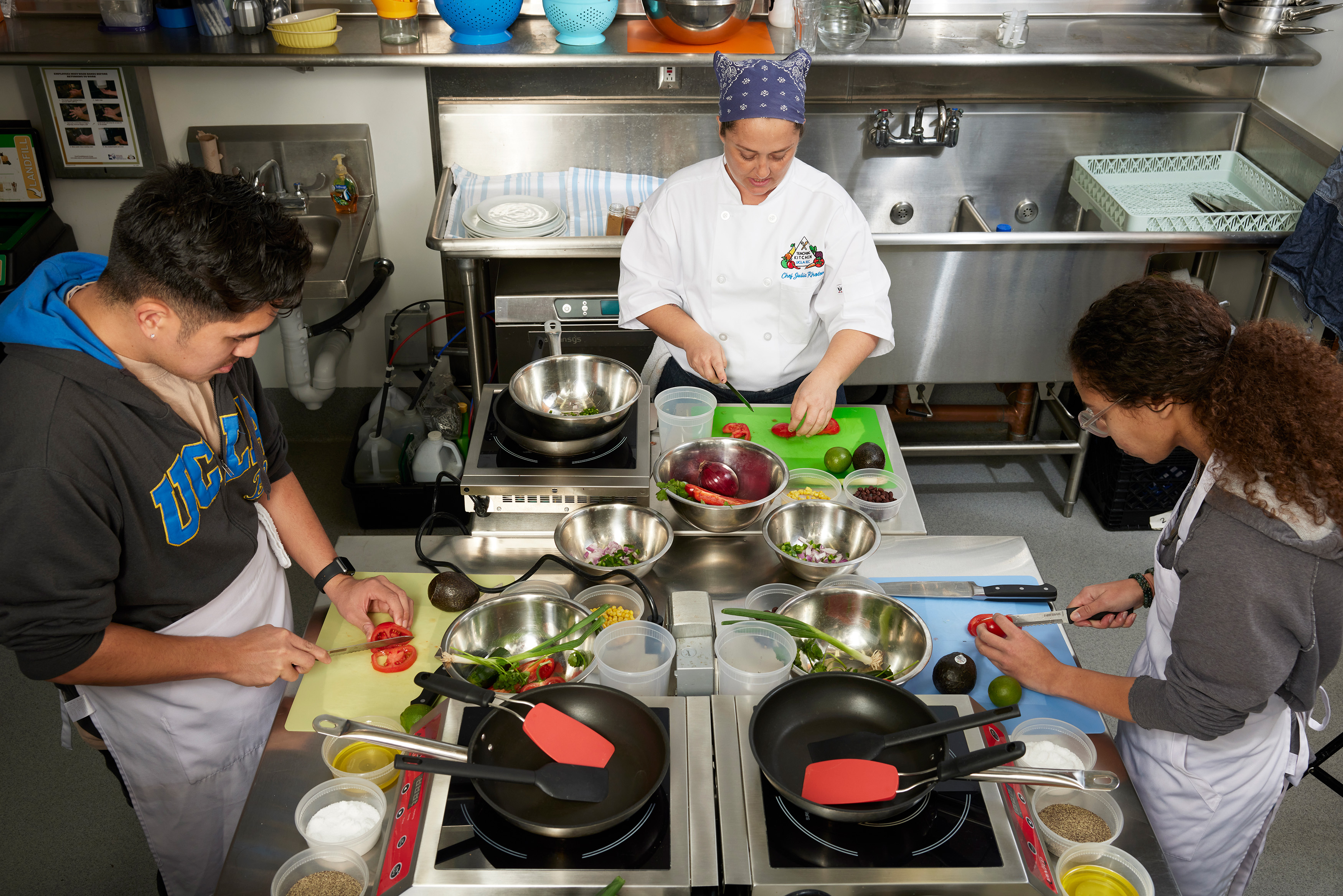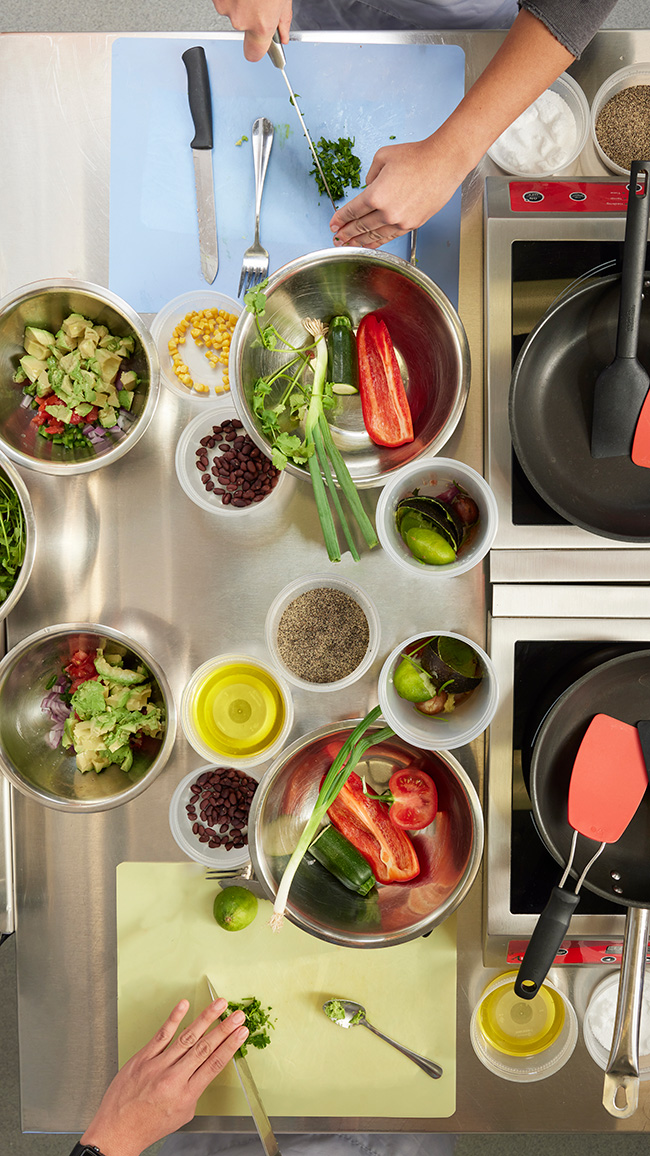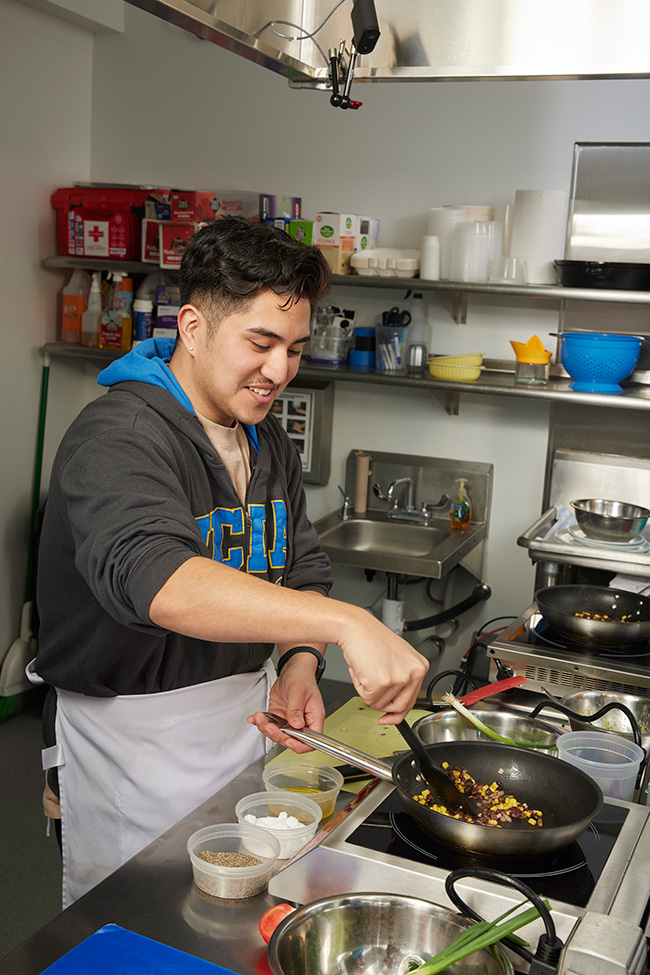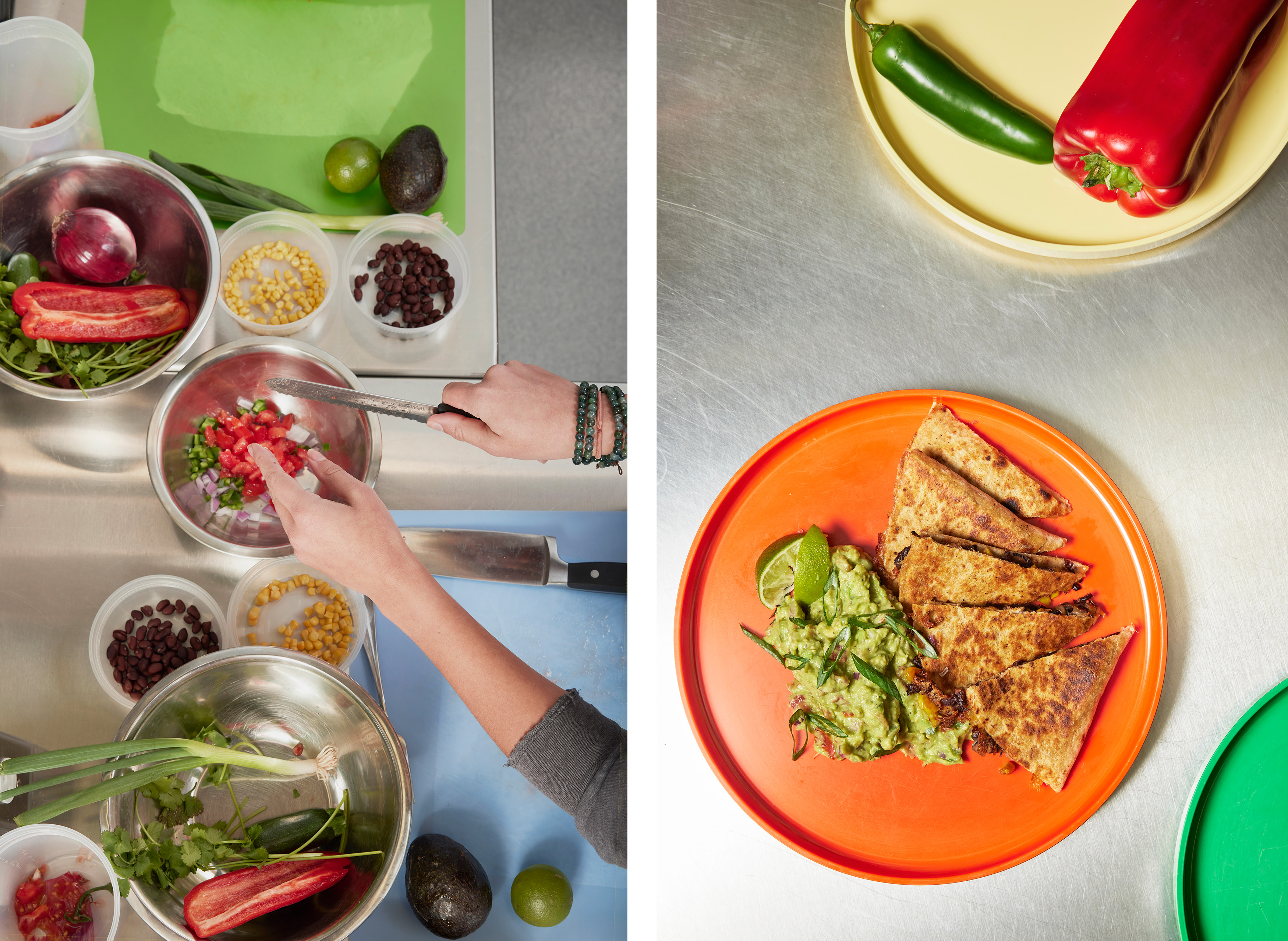The UCLA Teaching Kitchen is part of a whole new campus ecosystem putting Bruin ingenuity to work in the world of food.
It’s five minutes before Culinary Bootcamp even starts and I’ve already made my first mistake.
“Don’t use that sink,” Julia Rhoton, chef and culinary arts coordinator at the UCLA Teaching Kitchen, tells me. I’ve reached for the first faucet I see. But I should be using the small hand-washing sink, not one of the deep, three-compartment commercial kitchen sinks. Chef Julia’s soothing voice is a constant feature of bootcamp. She instructs, she explains, she cautions.
Designed to teach basic knife skills and cooking methods, Culinary Bootcamp — held at a clubhouse in the Los Angeles Tennis Center complex — is a single-session workshop that’s free to students, with all equipment and ingredients provided. Some of the students who enroll are minoring in food studies; others are merely hoping to learn some life skills. All will leave with a free, healthy meal: today, a veggie quesadilla and fresh guacamole.
But the impact of the Teaching Kitchen is much greater than cooking lessons. In this space, health sciences trainees master menus specific to chronic diseases; science students explore the origins of food texture and flavor; and campus groups hold team-building workshops.
The Teaching Kitchen is brightly lit, with no chairs or stools. Chilly stainless steel dominates: the sinks, the shelves, the prep tables. Each student is presented with a neatly folded apron. On this day, bowls — yet more stainless steel — hold a bright still life of vegetables: deep green avocados, zucchini and limes; a fistful of lacy cilantro; half a jalapeño; a quarter each of onion, red pepper and tomato. Thin plastic cutting mats add a patchwork of color, each overlaid with a chef’s knife. Countertop induction burners are shared, with one burner for each pair of students.

There isn’t much chatter as the six students arrive and don their aprons. Chef Julia looks stripped for action in a simple black T-shirt, her face bare of makeup and dark hair hidden by a neatly tied bandanna. It’s time to get started.
Guacamole first. Chef Julia posts the recipe on an overhead screen. Under her exacting eye, we tentatively pick up our knives.
The workshop is dense with insights, from how to properly grip a cutting knife to how to adapt a recipe for vegans. There’s even a reference to climate impact: the environmental trade-offs between fresh and frozen and local and imported ingredients. I learn a lot right off the bat: Cut a pepper from the inside. For onions, the trick is to leave the root end intact.
As neatly diced vegetables begin to crowd our cutting mats, another student appears. I mentally christen him Late Guy. He becomes my workstation partner.
We use forks to mash our avocados. We add diced tomato, onion, jalapeño and cilantro, to taste. I spill most of the chili powder on my cutting mat.
Chef Julia steps to my workstation, calmly flexes the mat and dumps the chili powder into compost. I’m embarrassed, but her shrug is reassuring, conveying “I’ve seen worse.” I rinse my chili powder-coated hands — in the proper sink.
Making social change through food
Launched in 2017, the Teaching Kitchen is both a place and a concept. UCLA is part of a network, the Teaching Kitchen Collaborative, that uses teaching kitchens as catalysts for change.
Chef Julia is a key player. She earned her culinary degree from the famed Le Cordon Bleu College of Culinary Arts and spent more than 17 years working and learning in Los Angeles kitchens. In 2018, she earned a degree in elementary education, but student teaching taught her something important about her own strengths and limitations. “I couldn’t stop worrying about the children when the school day ended,” she says. “Were they getting enough to eat?”
In 2019, Summer Discovery — an enrichment program that uses UCLA and other college campuses as venues — gave Rhoton a chance to work with older students. There, she came to the attention of UCLA Recreation; she ended up becoming UCLA’s first-ever culinary arts coordinator.

Today, the Teaching Kitchen mixes academic aspirations, student desires and administrative know-how in a creative, innovative blend. In 2014, Wendelin Slusser, associate vice provost for the Semel Healthy Campus Initiative at UCLA, convened a “Food Summit” on campus to brainstorm a vision for nurturing a world-class food studies program. More than 60 campus decision-makers — academics, administrators and student leaders — gathered to hammer out a wish list. “One of the dreams we had was to have a chef,” Slusser recalls. The food studies minor for undergraduates and the food studies certificate program for graduate students were created and approved in little more than a year. UCLA Recreation made space for a community garden at Sunset Canyon and offered the staging kitchen in the LA Tennis Center as a home for the Teaching Kitchen.
A UCLA food collaborative was born.
Learning is on the menu
Multiple campus departments pooled money to transform the catering prep kitchen into a culinary kitchen. Like many remodels, the project ran over budget. Alumna Marcie Rothman ’68, known on radio and TV as “The $5 Chef,” came to the rescue with the needed funds — and an enduring commitment to food studies at UCLA.
The completed Teaching Kitchen is a triumph of cross-campus cooperation. Slusser is proud that so many campus entities contributed, from her own Semel Healthy Campus Initiative to Recreation, the Community Programs Office, the College of Letters and Science and the David Geffen School of Medicine. “Our role is to open the doors and windows and silo-bust,” Slusser says, “so we can create a learning community that will better our own campus and beyond.”
Bruin Plate has the cuisine students want to know — and eat — better. Read the story.
UCLA biophysicist Amy Rowat was teaching “Science and Food: Physical and Molecular Origins of What We Eat” before a Teaching Kitchen was even dreamed of. She’s not nostalgic for those early days of searching for science classrooms uncontaminated by chemicals and improvising with hot plates, toaster ovens and extension cords. Now the Teaching Kitchen is the course’s laboratory, used by guest chefs and students alike. It’s not easy (read: it involves physics and math), but most students thrive in an atmosphere enhanced by guest chefs. The course typically ends in a “scientific bake-off,” where pies or other baked goods demonstrate the scientific whys and hows behind recipes.
Rowat, now UCLA’s Marcie H. Rothman Presidential Professor of Food Studies, taught “Perspectives on Food and Society” in Spring 2022. In that course, students considered broader issues that included climate, human health, health disparities and food access. For Rowat, a highlight of the course was the visit from African American chef Martin Draluck, who cooked over a live fire in the community garden. As they ate his savory rabbit and grits, students were mesmerized by learning about the chefs enslaved by Thomas Jefferson and George Washington. In their course evaluations, students used the word “revelation.” “They learned new ways of thinking about food and how it impacts society,” Rowat says.

Catherine Carpenter, who teaches nutrition to future health providers, knows that many chronic diseases can be prevented or managed with improved eating habits. When she started using the Teaching Kitchen, her course became a can’t-miss event, engaging and enjoyable. Students pursuing a master’s in nursing choose from sessions pegged to specific diseases such as diabetes, hypertension, atherosclerosis and colon cancer. “If we can provide the students with a lifestyle skill of cooking a healthy meal for lowering the risk of disease,” Carpenter says, “then they can teach their patients. And their patients can teach their families.”
Pilot efforts began in 2018. After the pandemic struck, Carpenter switched to a virtual model. She personally prefers the virtual approach, she says, because people can replicate what they’ve done in their own kitchens, using their own equipment. She’s working on a more polished online version of the course to reach even more health providers.
Cambria Garell was also involved in the pilot program. An associate clinical professor in pediatrics, her major focus is pediatric residents. Most of them, she says, have some working knowledge of cooking. Like Carpenter, Garell believes in a “train the trainer” approach. Health professionals who engage in healthy lifestyles themselves are more likely to counsel patients, and more effective when they do.
A pleasant surprise to Garell was that the Teaching Kitchen experience actually improved the behaviors of the pediatric residents involved — not just their nutrition, but in terms of healthier lifestyles (even including a little more sleep). Garell says, “There’s something about the community-building that happens around cooking together, learning together, delivering these skills to the community … that supports our own wellness as health care providers.”

Meanwhile, back at bootcamp …
Late Guy takes charge of our burner as Chef Julia explains the “HAHA” acronym: Heat the pan, Add the oil, Heat the oil, Add the veggies.
Late Guy adjusts our burner to 190 degrees. To our diced zucchini, onion and red pepper, we each add about a quarter-cup of corn and the same amount of black beans.
With the savory, sizzling smell of the cooking vegetables encouraging us, we cover our whole-wheat tortillas with shredded cheese. We layer the cooked veggies over the cheese-topped tortillas, then top with a plain tortilla.
Soon, the whole kitchen smells of fresh-cooked veggies and crisping tortillas. When it’s time to turn the quesadilla over, Chef Julia shows us a trick. She uses her spatula to lift the quesadilla from the pan, then inverts the pan over it and flips quesadilla and pan together. In minutes the second side is brown.
It’s almost the end of class time when I cut my quesadilla in quarters and put it in a container with my guacamole. It turns out Late Guy does not like either guacamole or quesadillas, but Chef Julia persuades him that his roommate might appreciate the free lunch.
Culinary Bootcamp is over, for today, but the Teaching Kitchen is just getting started. Extra teaching space has been added in UCLA’s newly opened Tipuana Apartments, where up to 30 students can be accommodated. Even more important is the establishment of the UCLA Rothman Family Institute for Food Studies, an interdisciplinary institute devoted to research, teaching and policy about food, which now houses the food studies minor and graduate certificate program. A gift of $13.5 million provides ongoing funding for research, curriculum and library resources, including the first endowed food studies librarian at a university, as well as more hands-on experiential learning opportunities and a chef-in-residence program.
UCLA, Chef Julia says, “is uniquely positioned as a leader in food studies.”
And its guac rocks, too.



